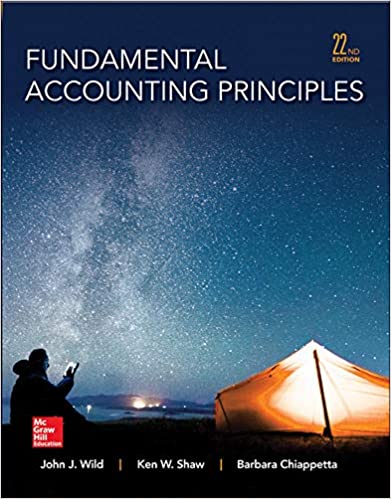
Fundamental Accounting Principles 22th Edition by John Wild ,Ken Shaw,Barbara Chiappetta
Edition 22ISBN: 978-0077862275
Fundamental Accounting Principles 22th Edition by John Wild ,Ken Shaw,Barbara Chiappetta
Edition 22ISBN: 978-0077862275 Exercise 25
The July transactions of Acorn Industries are described in Problem 7-2B.
Required
1. Prepare a general journal, a purchases journal like that in Exhibit 7.9, and a cash disbursements journal like that in Exhibit 7.11. Number all journal pages as page 3. Review the July transactions of Acorn Industries and enter those transactions that should be journalized in the general journal, the purchases journal, or the cash disbursements journal. Ignore any transactions that should be journalized in a sales journal or cash receipts journal.
2. Open the following general ledger accounts: Cash; Inventory; Office Supplies; Store Supplies; Store Equipment; Accounts Payable; Long-Term Notes Payable; R. Acorn, Capital; Sales Salaries Expense; and Advertising Expense. Enter the June 30 balances of Cash ($100,000), Inventory ($200,000), Long- Term Notes Payable ($200,000), and R. Acorn, Capital ($100,000). Also open accounts payable subsidiary ledger accounts for Charm's Supply, Teton Company, Drake Company, and Plaine, Inc.
3. Verify that amounts that should be posted as individual amounts from the journals have been posted. (Such items are immediately posted.) Foot and crossfoot the journals and make the month-end postings.
4. Prepare a trial balance of the general ledger accounts opened as required for part 2; then prepare a schedule of accounts payable.
Reference: Exhibit 7.11

Exhibit 7.9

Reference: Problem 7-2B
Acorn Industries completes these transactions during July of the current year (the terms of all its credit sales are 2/10, n/30).

Required
1. Prepare a sales journal like that in Exhibit 7.5 and a cash receipts journal like that in Exhibit 7.7. Number both journals as page 3. Then review the transactions of Acorn Industries and enter those transactions that should be journalized in the sales journal and those that should be journalized in the cash receipts journal. Ignore any transactions that should be journalized in a purchases journal, a cash disbursements journal, or a general journal.
2. Open the following general ledger accounts: Cash; Accounts Receivable; Inventory; Long-Term Notes Payable; R. Acorn, Capital; Sales; Sales Discounts; and Cost of Goods Sold. Enter the June 30 balances for Cash ($100,000), Inventory ($200,000), Long-Term Notes Payable ($200,000), and R. Acorn, Capital ($100,000). Also open accounts receivable subsidiary ledger accounts for Kim Nettle, Ashton Moore, and Ruth Blake.
3. Verify that amounts that should be posted as individual amounts from the journals have been posted. (Such items are immediately posted.) Foot and crossfoot the journals and make the month-end postings.
4. Prepare a trial balance of the general ledger accounts opened as required for part 2; then prove the accuracy of the subsidiary ledger by preparing a schedule of accounts receivable.
Analysis Component
5. Assume that the total for the schedule of accounts receivable does not equal the balance of the controlling account in the general ledger. Describe steps you would take to discover the error(s).
Reference: Exhibit 7.5

Exhibit 7.7

Required
1. Prepare a general journal, a purchases journal like that in Exhibit 7.9, and a cash disbursements journal like that in Exhibit 7.11. Number all journal pages as page 3. Review the July transactions of Acorn Industries and enter those transactions that should be journalized in the general journal, the purchases journal, or the cash disbursements journal. Ignore any transactions that should be journalized in a sales journal or cash receipts journal.
2. Open the following general ledger accounts: Cash; Inventory; Office Supplies; Store Supplies; Store Equipment; Accounts Payable; Long-Term Notes Payable; R. Acorn, Capital; Sales Salaries Expense; and Advertising Expense. Enter the June 30 balances of Cash ($100,000), Inventory ($200,000), Long- Term Notes Payable ($200,000), and R. Acorn, Capital ($100,000). Also open accounts payable subsidiary ledger accounts for Charm's Supply, Teton Company, Drake Company, and Plaine, Inc.
3. Verify that amounts that should be posted as individual amounts from the journals have been posted. (Such items are immediately posted.) Foot and crossfoot the journals and make the month-end postings.
4. Prepare a trial balance of the general ledger accounts opened as required for part 2; then prepare a schedule of accounts payable.
Reference: Exhibit 7.11

Exhibit 7.9

Reference: Problem 7-2B
Acorn Industries completes these transactions during July of the current year (the terms of all its credit sales are 2/10, n/30).

Required
1. Prepare a sales journal like that in Exhibit 7.5 and a cash receipts journal like that in Exhibit 7.7. Number both journals as page 3. Then review the transactions of Acorn Industries and enter those transactions that should be journalized in the sales journal and those that should be journalized in the cash receipts journal. Ignore any transactions that should be journalized in a purchases journal, a cash disbursements journal, or a general journal.
2. Open the following general ledger accounts: Cash; Accounts Receivable; Inventory; Long-Term Notes Payable; R. Acorn, Capital; Sales; Sales Discounts; and Cost of Goods Sold. Enter the June 30 balances for Cash ($100,000), Inventory ($200,000), Long-Term Notes Payable ($200,000), and R. Acorn, Capital ($100,000). Also open accounts receivable subsidiary ledger accounts for Kim Nettle, Ashton Moore, and Ruth Blake.
3. Verify that amounts that should be posted as individual amounts from the journals have been posted. (Such items are immediately posted.) Foot and crossfoot the journals and make the month-end postings.
4. Prepare a trial balance of the general ledger accounts opened as required for part 2; then prove the accuracy of the subsidiary ledger by preparing a schedule of accounts receivable.
Analysis Component
5. Assume that the total for the schedule of accounts receivable does not equal the balance of the controlling account in the general ledger. Describe steps you would take to discover the error(s).
Reference: Exhibit 7.5

Exhibit 7.7

Explanation
1.
The general journal would report thos...
Fundamental Accounting Principles 22th Edition by John Wild ,Ken Shaw,Barbara Chiappetta
Why don’t you like this exercise?
Other Minimum 8 character and maximum 255 character
Character 255


